GDPR non-compliance will cost those who risk it up to 4% of global turnover. But even without GDPR fines, most marketers know that dirty data hits the bottom line. Royal Mail research has revealed what brands and agencies are doing to plug the 'leaky bucket' of customer churn – to cleanse, validate and improve the quality of the data they hold. Jim Conning examines the findings.
Marketers face churn rates which see nearly one in five (19%) customers defect every year, according to research from Royal Mail Data Services (RMDS). Unsurprisingly, this means finding and acquiring new customers remains the number one challenge for 42% of them.
How are they coping with churn and what are their customer data headaches? The RMDS research, conducted with brands and marketing agencies from across the UK, uncovered key trends in four areas:
1. Growing headaches – from the GDPR to integration
Given its implementation date of 25 May 2018, the General Data Protection Regulation (GDPR) is the most pressing headache for nearly one-third (29%) of marketers. And while 78% were either “very” or “reasonably” confident that their internally held customer data complied with the new regulation, just 43% of respondents had the same level of confidence in third-party data. This demonstrates the difficulty of gathering evidence that the right permissions are in place when data has come from other sources.
Aside from the GDPR, the next biggest concern around customer data management is dealing with legacy systems (cited by 28% of all respondents and 37% of brands). These can be inflexible and difficult to use, and act as blocks on using data to effectively meet wider marketing challenges.
2. Bridging the gaps in data marketing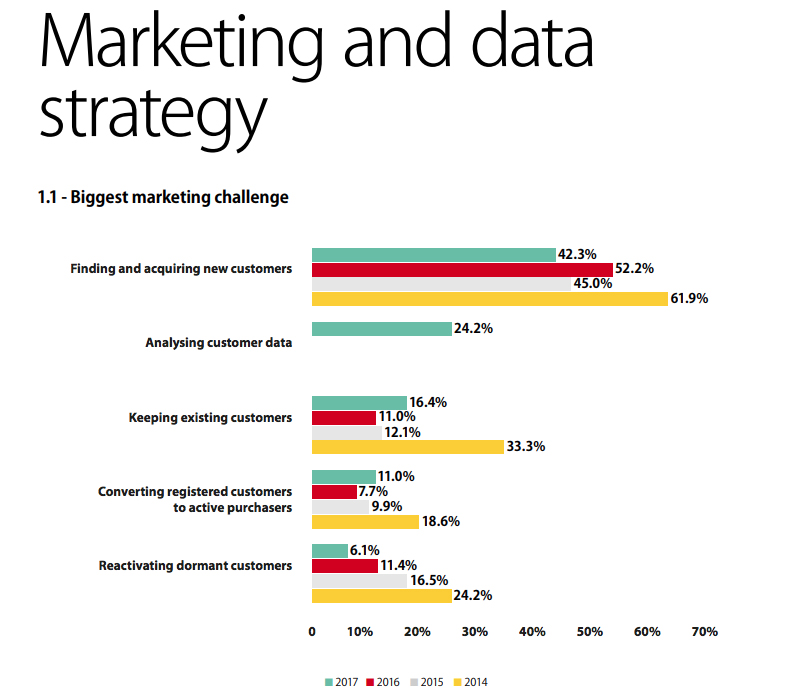
When companies were asked what would improve their performance, nearly one-quarter (24%) pointed to analysing customer data as their biggest issue, a figure that rose to 28% within brands. This demonstrates a clear need for greater analytics skills and capabilities.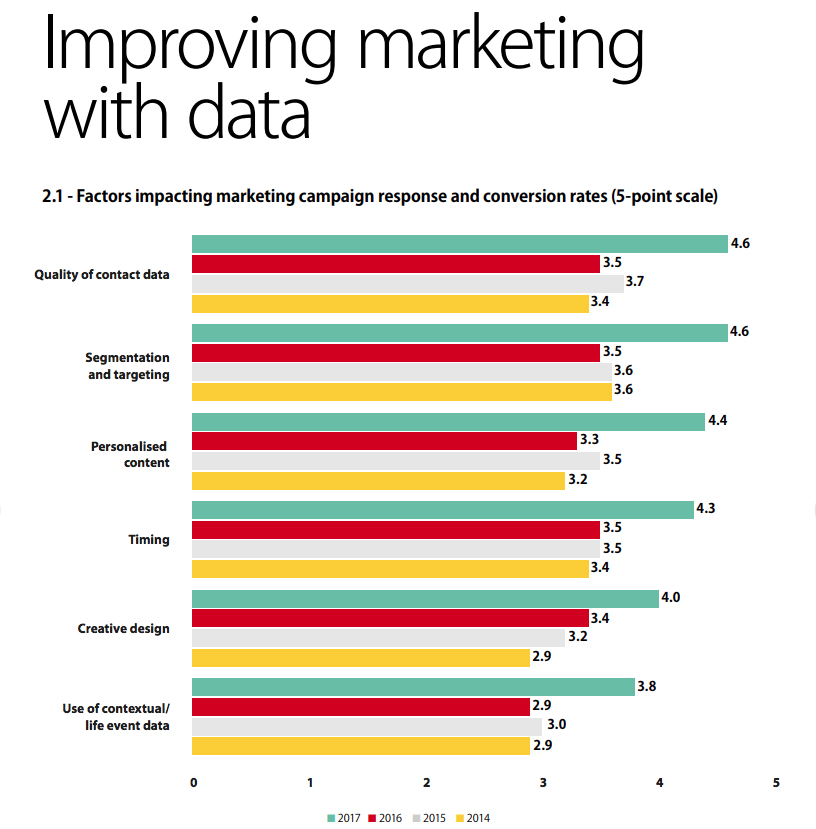
A point that perhaps reflects that they already had analytics skills, the biggest area for improvement that marketing agencies flagged (29%) was access to better quality customer data. Figures for this were lower for brands (18%), due to the larger, more granular amount of customer data they tended to hold, though the gap between brands and agencies points to a lack of data sharing when the two work on campaigns together.
Marketers agree that success is all about data and how you use it. On a scale of one to five, the four top success factors reported were quality of contact data (4.6), segmentation and targeting (4.6), personalised content (4.4) and timing (4.3). In comparison, creative design scored just 4.0 out of 5. These top four factors all rely on good quality data and analytics in some way, and marketers reported that they had all increased in importance dramatically since 2016.
3. Overcoming data quality challenges
Eighteen per cent of marketers listed poor quality customer data as their biggest challenge. Marketers cited basic errors as the main cause of this, specifically out-of-date information and incomplete data.
Data validation is an essential part of maintaining good data quality. The positive news is that this is becoming an increasingly automated process, both on websites (for which 46% of marketers said they automatically checked address data) and in internal systems (40% automatic checks). However, nearly one in five (19%) marketers said they didn’t validate website data, and 16% didn’t check data coming into internal systems at all. An additional one-quarter (25%) relied on manual address checks in internal systems. At a time when good quality customer data and operational efficiency are high on the marketing agenda, there is clearly a need for brands and agencies alike to find new ways to automate the continuous cleansing and validation of customer data.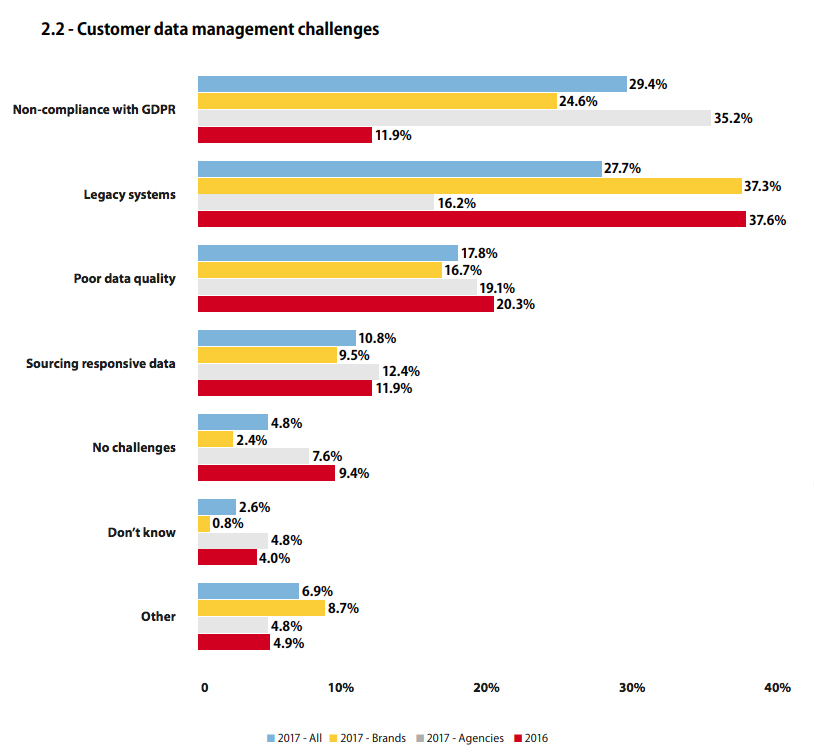
Data quickly becomes out of date and loses its value. To combat this, brands and agencies are focusing on more formal, regular data cleansing – 22% said they did this daily or continuously, and just 11% annually (down from 14% in 2016). However, one-third (33%) still had no formal processes in place to clean customer contact data, although this had dropped from 37% in 2016. This means a sizeable minority are putting themselves at risk of data-quality issues – and potential GDPR investigations over non-compliance.
4. Casting the customer data net more widely
Increasingly, marketers are looking outside their organisations when it comes to customer data. In 2016 nearly-half (49%) had used data collected by themselves, a figure that dropped to 42% in 2017. Self-collected data came from a variety of owned channels, led by their websites (92%), direct sales (56%) and company contact centres (45%).
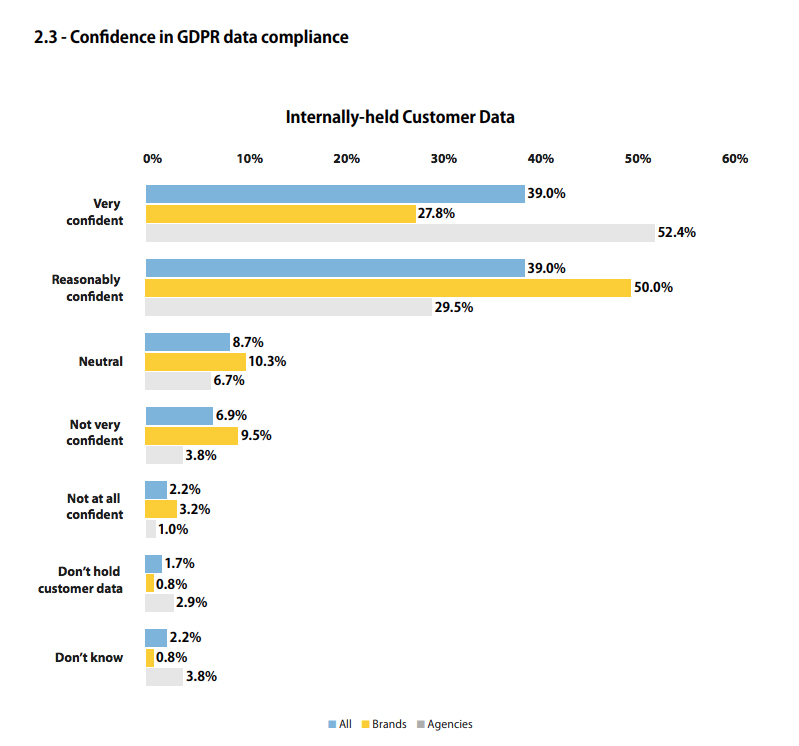 Rather than relying solely on their own sources, marketers are now looking to enrich the data they hold with information from third-party data providers – 50% said they now followed this strategy (up from 47%). This jump may partly be down to the GDPR, with marketers using external sources to help them gain consent by working with reputable and compliant third-party providers ahead of the 25th May 2018 deadline.
Rather than relying solely on their own sources, marketers are now looking to enrich the data they hold with information from third-party data providers – 50% said they now followed this strategy (up from 47%). This jump may partly be down to the GDPR, with marketers using external sources to help them gain consent by working with reputable and compliant third-party providers ahead of the 25th May 2018 deadline.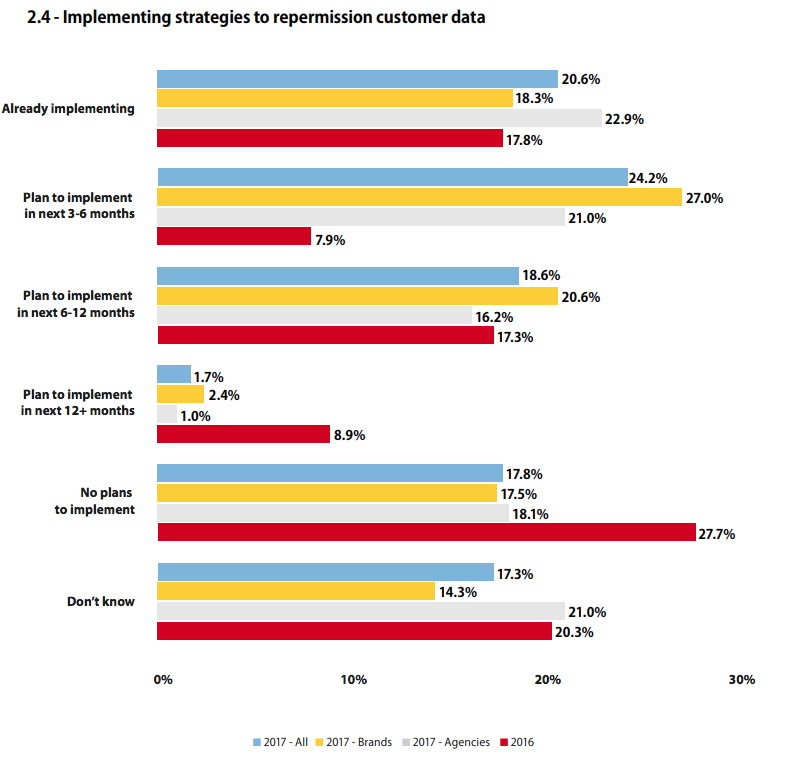
The most common third-party data used to enrich internally held customer data was email addresses (43%), followed by demographic data (37%) and enhanced address data (30%). These headline figures mask major differences between agencies and brands. Sixty-two per cent of agencies relied on email address enrichment (against 28% of brands), with in-house marketers instead focusing on demographic (35%) and address data (22%). In fact, agencies overwhelmingly said they used more third-party sources to enrich their data, which shows the relative lack of customer information they hold compared to brands.
Even without GDPR fines (which can be up to 4% of global turnover), poor quality data hits the bottom line. Marketers recognised this, estimating the average cost of poor quality customer data at 6% of annual revenue. For major brands this is measured in millions of pounds – and even this may not be the complete picture. Poor quality data impedes overall marketing performance, impacts response rates and reduces conversion rates, making the overall cost potentially much higher.
Challenges around best practice and GDPR non-compliance
Marketers have access to more customer data than ever before, but to successfully turn this into improved campaigns, conversions and revenues, they still face key challenges around compliance, skills and following best practice. As the Royal Mail Data Services research demonstrates, some are forging ahead while others seem to be falling behind. This means poor quality data and manual processes will hamper their ability to compete.
The Royal Mail Data Services report, ‘The use and management of customer data‘, can be downloaded here.
Have an opinion on this article? Please join in the discussion: the GMA is a community of data driven marketers and YOUR opinion counts.





 Rather than relying solely on their own sources, marketers are now looking to enrich the data they hold with information from third-party data providers – 50% said they now followed this strategy (up from 47%). This jump may partly be down to the GDPR, with marketers using external sources to help them gain consent by working with reputable and compliant third-party providers ahead of the 25th May 2018 deadline.
Rather than relying solely on their own sources, marketers are now looking to enrich the data they hold with information from third-party data providers – 50% said they now followed this strategy (up from 47%). This jump may partly be down to the GDPR, with marketers using external sources to help them gain consent by working with reputable and compliant third-party providers ahead of the 25th May 2018 deadline.



Leave your thoughts